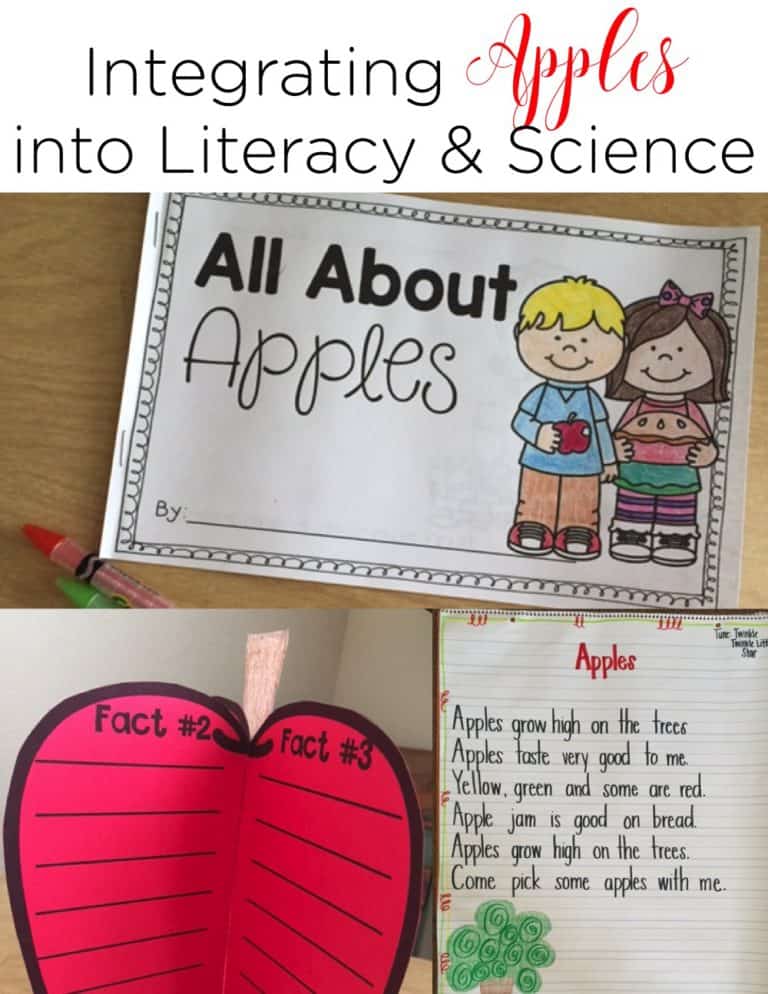


I have a brand new, updated post about Reading Small Groups with Pre-Readers with the Science of Reading in Mind that you may also find helpful!
One question I get more than any other is, “What do I do for guided reading with non-readers?” It’s a very common question and a very realistic question. We ALL have non-readers at some point in our kindergarten or first grade classrooms. Maybe you even have a non-reader in a second grade classroom.
The answer is simple: “You meet with them consistently, coach them, and help them become readers.”
You might be thinking to yourself, “Well that sounds great, but I still don’t know what to do with my group.” Great! Let’s dive into how to teach guided reading with non-readers!
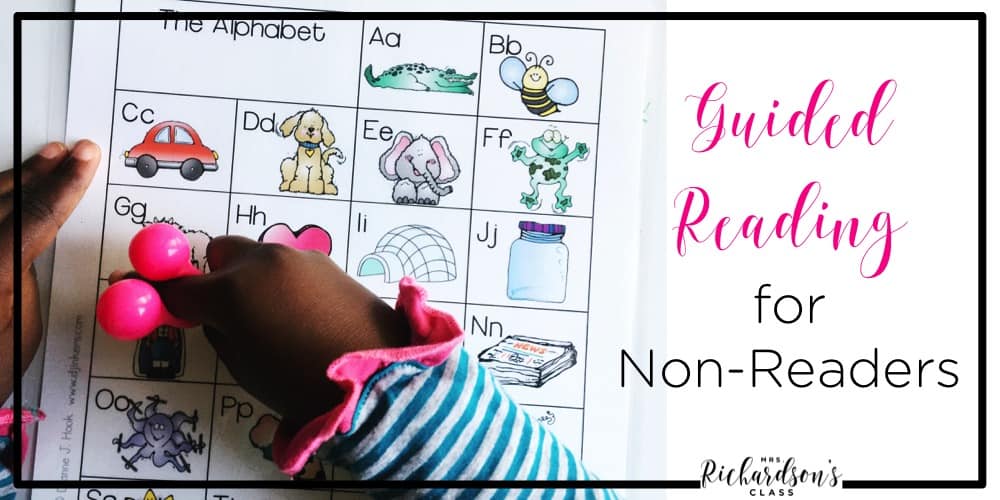
When getting started, it’s important to remember that you have set what I like to call “table expectations”. These little ones will probably need constant reminders of what you expect of them at the table.
For my students who are reading this looks different. I expect them to get their book from their folder and come to table, quietly warm up their brain by reading their book, then place the book under their chair.
When it comes to a guided reading lesson outline, I like what Jan Richardson suggests in her book The Next Step in Guided Reading. Unknowingly, this is roughly what I have followed since I first started teaching in 2008. She suggests the following 4 areas of focus.
Typically, here is how a guided reading with non-readers session was structured in my classroom. 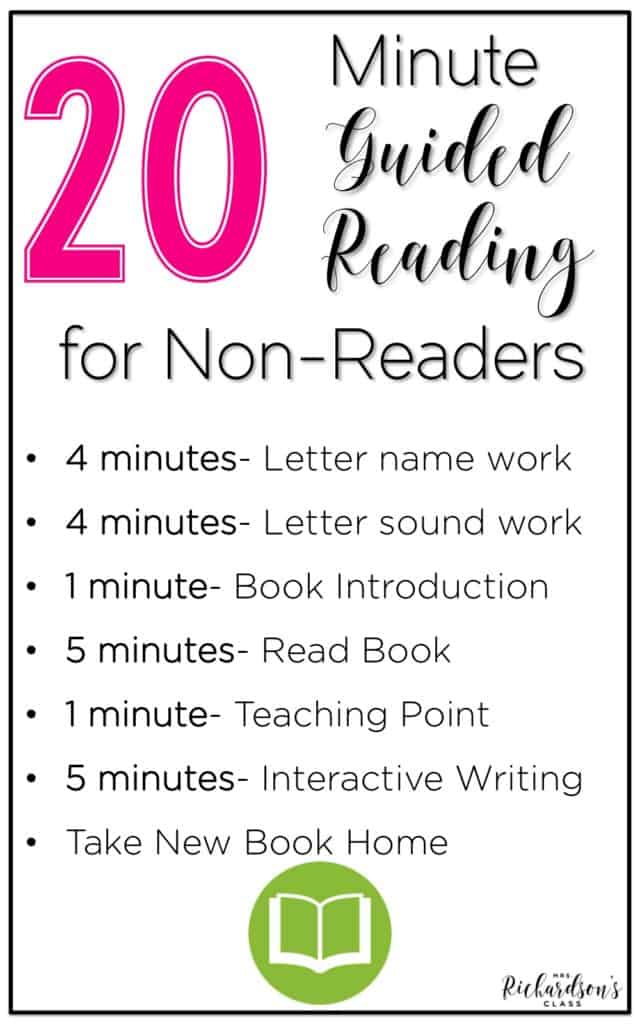
I like to have an alphabet chart out at each student’s spot. We sing a little chant as we name each picture or letter and then we make the sound. It goes like this, “Apple, apple, /a/, /a/, /a/.” Or it could go, “A, a, /a/, /a/, /a/.” We do this every single day as we work on solidifying letter sound knowledge and one-to-one correspondence.
Another great activity to do that practices letters and sounds is a tracing alphabet book. This doesn’t work with pencil and paper, but with their finger and paper. It’s all about the tactile experience. Check out my post on letter tracing and grab the FREE letter tracing book to use in your classroom. You can reuse them year after year, too!
I have seen the benefit in my own home with my non-reader who is an ELL. If a student is struggling with this, you could always start with the letters they have in their name. Names are powerful and I used them for many, many things with my non-readers!
As you continue to work on building their letter knowledge, you also want them to learn how letters and sounds work together. We did this often times through phonemic awareness games–rhyming matching, syllable puzzles, and much more!
The next thing we will do is use a book. Yes, we use books even though they cannot decode the text on their own. Here is why: our readers will never learn concepts about print without actually interacting with text.
They also feel like readers when you give them books. They are empowered and encouraged! They have to know early literacy skills and strategies to become good readers.
One of the best things you can do with these little non-readers is to create the text with them. It’s so simple and so powerful!
When we make the book together, I always choose 1 or 2 sight words and I either have the kids write them, or I pre-write them on the pages. If I have pre-written the words, then we do a little sight word work with the words–build them with magnetic letters, write them and read them 3 times fast on our dry erase boards, or orally use them in a sentence.
After they add their pictures of choice, then I will write the words that match the picture. For example, I see cats. Keep in mind that if you want everyone to have the same book or you have more than 1 non-reader, you are going to have to guide the picture adding so that this happens.
You can also always use a simple level A guided reading book. Remember, you are coaching them through this–not having them read the book independently. If they can do that, they are a reader! (Go here to read about your guided reading routine with them!)
Now we are ready to read. Begin by having the students each share orally what is happening on each page by reading the picture. At the beginning, you will have to model this for the students. “I see a boy playing with a ball. He looks happy.”
Most of the time during guided reading, we never, ever, ever choral read, but with these precious non-readers, we bend that rule. You will begin by choral reading the text together. After you have done this one to two times and you know they can fly on their own, let them read it independently. This is when you will listen in to a few of them, take notes in your guided reading binder, and identify teaching points you want to make after they have all read it two to three times independently.
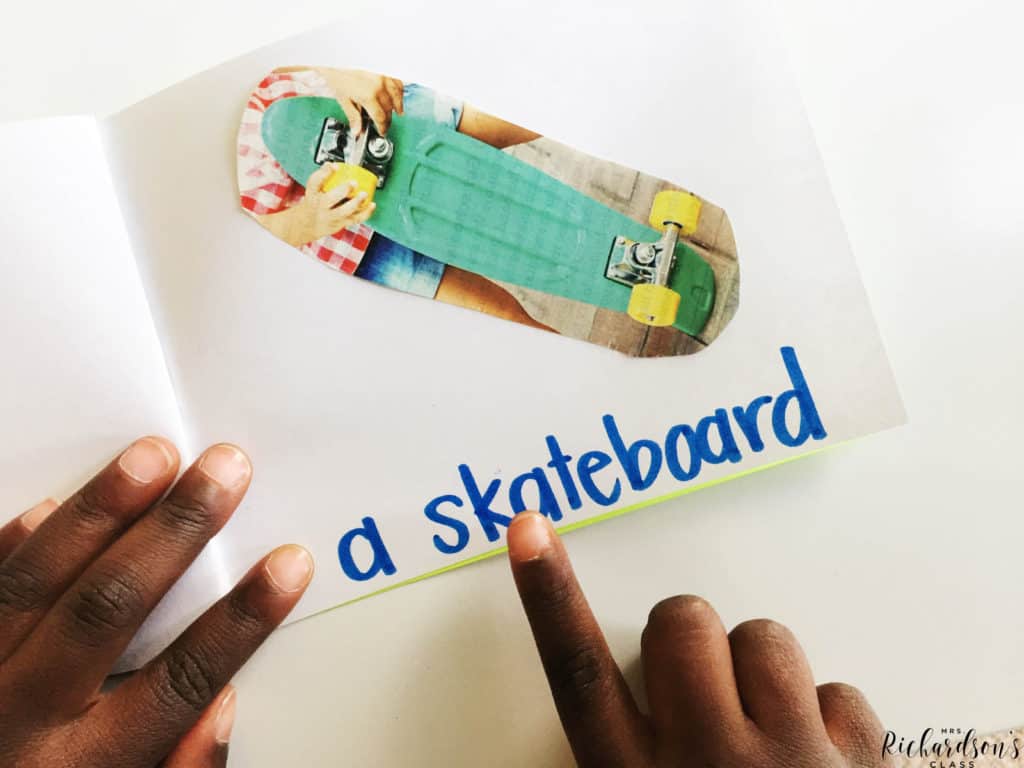 Below are some teaching points and things to focus on:
Below are some teaching points and things to focus on:
A great way to include interactive writing is to close the session with a short time of interactive writing. I always try to squeeze this in with my guided reading groups, but I don’t always have time. Also, there are times that it takes more time than it should. Remember to keep it short and sweet.
I like to simply have the students help me write a sentence. They dictate and I write. Sometimes I make it shared writing and they share the pen with me, but most of the time I do the writing while they dictate the sentence. The main reason is because I want to model proper writing, not inventive spelling. I do allow that and praise that, but not when I am trying to teach these skills. I constantly have them interacting with me.
For example, I might say:
After we write the sentence we read it all together. If we have time still, we cut it up and build it back. This is an activity that I do often with my guided reading groups that are levels A-C. They simply need the support and skill modeling and direction that is provided with this activity.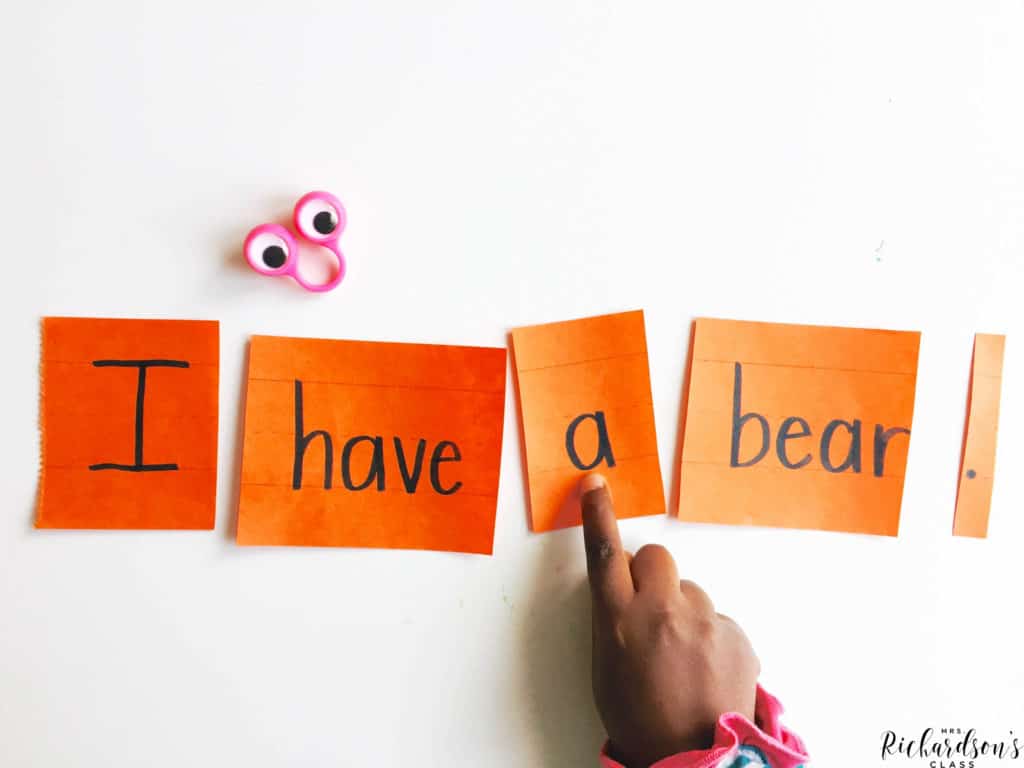
When we are done with the group time, I always send the books home with my students to practice reading that night. They are SO proud to read their book to their parents that we have practiced and that they CAN READ! They feel like readers and that, my friends, is a powerful thing!
If you are looking for more direction with planning your group time once they are officially reading on a level A or above, check out this post HERE.
pin it

Want to use the latest research to boost your readers during small groups? This FREE guide is packed with engaging ideas to help them grow!

I’m a K-1 teacher who is passionate about making lessons your students love and that are easy to implement for teachers. Helping teachers like you navigate their way through their literacy block brings me great joy. I am a lifelong learner who loves staying on top of current literacy learning and practices. Here, you’ll find the tools you need to move your K-2 students forward!


| Cookie | Duration | Description |
|---|---|---|
| cookielawinfo-checkbox-analytics | 11 months | This cookie is set by GDPR Cookie Consent plugin. The cookie is used to store the user consent for the cookies in the category "Analytics". |
| cookielawinfo-checkbox-functional | 11 months | The cookie is set by GDPR cookie consent to record the user consent for the cookies in the category "Functional". |
| cookielawinfo-checkbox-necessary | 11 months | This cookie is set by GDPR Cookie Consent plugin. The cookies is used to store the user consent for the cookies in the category "Necessary". |
| cookielawinfo-checkbox-others | 11 months | This cookie is set by GDPR Cookie Consent plugin. The cookie is used to store the user consent for the cookies in the category "Other. |
| cookielawinfo-checkbox-performance | 11 months | This cookie is set by GDPR Cookie Consent plugin. The cookie is used to store the user consent for the cookies in the category "Performance". |
| viewed_cookie_policy | 11 months | The cookie is set by the GDPR Cookie Consent plugin and is used to store whether or not user has consented to the use of cookies. It does not store any personal data. |
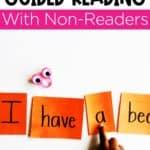
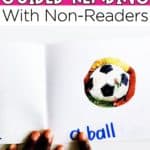
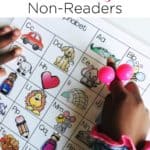
19 Responses
Thede are great ideas. Guided reader works great for some but for others it can be a real struggle.
These ideas coupled with behaviour controls such as reward charts etc can be a life saver! Thanks for sharing such a useful post!
Yes! Behavior can be a whole other ball game to figure out sometimes. You are right, though. It has to be under control before time at your table will be effective. You are very welcome, Ginger!
Another simple idea put into action. You have your finger on what is essential and see through the fluff. Sometimes we get so bogged down in the ‘stuff’ we lose focus on the goal. Thanks.
Thank you for sharing your ideas! I’m excited to use these ideas with a couple of my students in my special needs classroom after our spring break!
What are your other groups doing during guided reading? I teach kindergarten and I have a difficult time coming up with ideas that are beneficial to the other groups and not just “busy work” I do books on tape which my students love, but I need ideas for my other three groups! I love your ideas!
Hi Connie! Thank you for your kind words! While I pulled guided reading groups, my other students rotated through literacy stations. You can read more about them here in this blog post! Let me know if you have any other questions at all! I am happy to help any time! 🙂
https://www.mrsrichardsonsclass.com/beginning-literacy-stations/
can you make something with how you break down your 20 minute times for reading like you show here that can be downloaded for all reading levels? I find this helpful as I am just starting with guided reading and need a beginning schedule to follow.
Hi Gina! I have something here that may be helpful! https://www.mrsrichardsonsclass.com/look-guided-reading-lesson/
hello!
I am a subscriber and I am trying to plan for a Pre-A reader in my class, who happens to be a selective mute! (yep, you read that correctly, everything is on the down low with her)
My question is about the interactive writing, how do you prompt the students to dictate a sentence to you? You example is about a bear, how do they even begin to think about a bear? 🙂
Thank you!
Usually, I bring up a topic we have explored together or an experience that we have experienced together. “Tell me more about ____!”
I would like to receive the updates to your blog 🙂
Hi Jannett! The best thing to do is to subscribe to my email list! I will email you updates there! 🙂 You can just drop your email in any of the boxes on my website! If you are most interested in guided reading things, then be sure to snag the freebie that you get for signing up for my list.
Thanks for all the great ideas!
I’m very excited to have found your blog. Do you happen to have a planning sheet you use for your groups? I would love to see it if you do!
Hi Kerry! You can see a bit more in this blog post! https://www.mrsrichardsonsclass.com/identifying-teaching-point-guided-reading/ You can also get the planning sheets as a part of my guided reading binder. https://www.teacherspayteachers.com/Product/Guided-Reading-Binder-300964